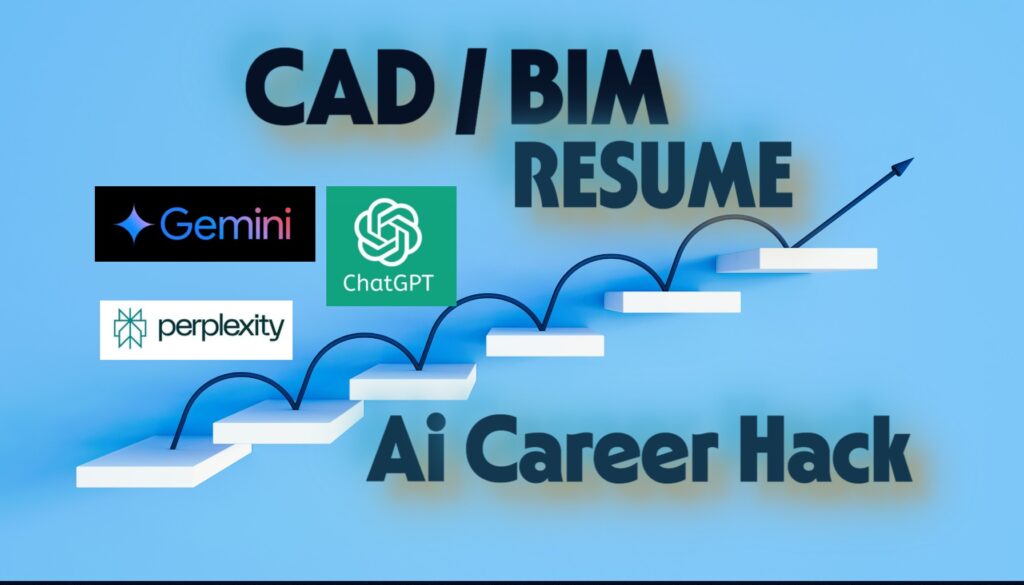I’ve been working with CAD professionals for years, and I keep hearing the same concerns: “The industry is changing so fast,” “I don’t know if my skills will be relevant,” and “How do I compete with younger graduates who are already equipped with BIM?”
Here’s what I’ve learned: the best CAD technicians aren’t necessarily the ones with the newest skills—they’re the ones who know how to adapt smartly. And right now, AI tools are the secret weapon most people aren’t using yet.
Why This Matters Now
If you’re comfortable with AutoCAD, Word, Excel, and basic internet research, you’re already ahead of many people. But the construction and engineering world is moving toward more collaborative, data-rich workflows. Companies want technicians who can work with BIM models, coordinate between teams, and handle complex project data.
The gap between traditional 2D CAD work and these new roles might seem huge, but it’s not. You just need the right approach.
Finding Real Opportunities with Perplexity
Instead of scrolling through endless job boards, I started using Perplexity (it’s like Google but smarter) to understand what employers actually want right now.
Try this search: “CAD technician jobs posted in the last 30 days requiring AutoCAD, basic Microsoft Office skills, minimal experience”
What you’ll find might surprise you. Many companies are specifically looking for people with your exact background—they just phrase it differently than you might expect. I’ve seen listings for “BIM Coordinator Assistant,” “Design Support Specialist,” and “CAD/BIM Hybrid roles” that are perfect for experienced AutoCAD users ready to expand.
Making Your CV Work Harder
Here’s where ChatGPT becomes incredibly useful. Instead of having one generic CV, you can create targeted versions for different types of roles.
I take job descriptions I found through Perplexity and ask ChatGPT: “Help me rewrite my CV to highlight how my AutoCAD experience, attention to detail, and project coordination skills match this job description.”
The key is being specific about your experience. Don’t just say “proficient in AutoCAD.” Say “created detailed technical drawings for 50+ residential projects, ensuring accuracy and compliance with local building codes.”
Planning Your Next Steps
This is where AI really shines. Instead of guessing what skills to learn next, I ask Gemini or ChatGPT something like: “I’m a CAD technician with 3 years of AutoCAD experience. What’s the most strategic skill I could learn in the next 6 months to increase my earning potential?”
The answers are usually spot-on. Revit comes up a lot, but so do tools like Navisworks for project coordination, Civil 3D for infrastructure work, and even basics of Dynamo for automation.
The BIM Question
Everyone asks about BIM, and honestly, it’s not for everyone—and that’s okay. But what I’ve noticed is that even learning BIM basics makes you more valuable in traditional CAD roles. You start thinking about projects differently, understanding how your drawings fit into larger workflows.
If you’re curious about BIM, start small. Ask AI to create a learning plan: “Give me a 3-month plan to learn enough Revit to be useful on a BIM team, using free resources.”
What Actually Works
After trying these approaches with dozens of CAD professionals, here’s what consistently gets results:
Start with one job application per week where you use AI to customize your CV specifically for that role. Don’t apply to everything—apply strategically to roles that are genuine steps forward.
Learn one new software feature or tool each month. Use AI to create bite-sized learning goals. “This month I’ll learn how to create parametric blocks in AutoCAD” or “I’ll complete the first three Revit tutorials.”
Network with purpose. Ask ChatGPT to help you write LinkedIn messages to BIM coordinators or senior CAD technicians at companies you’re interested in. Most people are happy to share their experience if you ask thoughtfully.
Beyond the Tools
The biggest advantage isn’t the AI tools themselves—it’s the mindset shift. Instead of feeling overwhelmed by industry changes, you start seeing them as puzzles to solve. Need to understand a job description? Ask AI to break it down. Wondering about salary ranges? Research it systematically.
You stop reacting to change and start preparing for it.
Getting Started Today
Don’t try to do everything at once. Pick one thing: maybe it’s researching five specific job openings, or rewriting your CV for one role you’re genuinely excited about, or asking AI to create a learning plan for one new skill.
The construction and engineering industries need experienced, reliable people who can bridge traditional methods with new technologies. That’s exactly what you are—you just need to position yourself correctly.
Want to see exactly how to use these AI tools step-by-step? Watch the complete tutorial:
What’s holding you back from trying these approaches? I’d love to hear about your biggest career challenges—drop me a comment or message.


